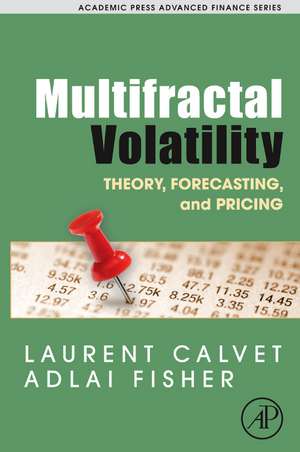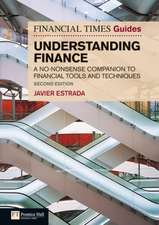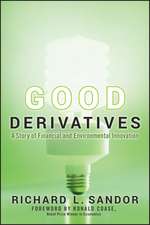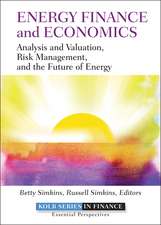Multifractal Volatility: Theory, Forecasting, and Pricing: Academic Press Advanced Finance
Autor Laurent E. Calvet, Adlai J. Fisheren Limba Engleză Hardback – 13 oct 2008
- Presents a powerful new technique for forecasting volatility
- Leads the reader intuitively from existing volatility techniques to the frontier of research in this field by top scholars at major universities
- The first comprehensive book on multifractal techniques in finance, a cutting-edge field of research
Preț: 408.20 lei
Preț vechi: 494.35 lei
-17% Nou
Puncte Express: 612
Preț estimativ în valută:
78.13€ • 84.33$ • 65.51£
78.13€ • 84.33$ • 65.51£
Carte tipărită la comandă
Livrare economică 12-26 aprilie
Preluare comenzi: 021 569.72.76
Specificații
ISBN-13: 9780121500139
ISBN-10: 0121500136
Pagini: 272
Ilustrații: Illustrated
Dimensiuni: 152 x 229 x 23 mm
Greutate: 0.57 kg
Editura: ELSEVIER SCIENCE
Seria Academic Press Advanced Finance
ISBN-10: 0121500136
Pagini: 272
Ilustrații: Illustrated
Dimensiuni: 152 x 229 x 23 mm
Greutate: 0.57 kg
Editura: ELSEVIER SCIENCE
Seria Academic Press Advanced Finance
Public țintă
Finance practitioners, academics, and students, and econometriciansSecondary readership: Mathematicians, statisticians, and natural scientists interested in fractalsCuprins
Preface
Chapter 1 Introduction
Chapter 2 Background
Chapter 3 The Multifractal Volatility Model: The MMAR
Chapter 4 The Marko-Switching Multifractal (MSM) in Discrete Time
Chapter 5. Multivariate MSM
Chapter 6 The Marko-Switching Multifractal in Continuous Time
Chapter 7 Multifrequency News and Stock Returns
Chapter 8 Multifrequency Jump Diffusions
Chapter 9 Conclusion
Appendices
Chapter 1 Introduction
Chapter 2 Background
Chapter 3 The Multifractal Volatility Model: The MMAR
Chapter 4 The Marko-Switching Multifractal (MSM) in Discrete Time
Chapter 5. Multivariate MSM
Chapter 6 The Marko-Switching Multifractal in Continuous Time
Chapter 7 Multifrequency News and Stock Returns
Chapter 8 Multifrequency Jump Diffusions
Chapter 9 Conclusion
Appendices
Recenzii
Advance Praise for Multifractal Volitility
“I thoroughly enjoyed reading the book and highly recommend it. The authors masterfully present their work on the Markov-Switching Multifractal model and its implications for Asset Pricing. This is a wonderful contribution to the field of Financial Economics.” --Ravi Bansal, J.B. Fuqua Professor of Finance, Duke University Durham, NC
“I have always been intrigued by the multi-fractal approach to volatility modeling, forecasting and pricing pioneered by Calvet and Fisher. This book does a wonderful job in gathering together all of the fundamental ideas and results in a coherent framework, and I highly recommend it to anybody interested in learning more about these novel techniques and how they compare to the more traditional GARCH and stochastic volatility based modeling procedures.” --Tim Bollerslev, Juanita and Clifton Kreps Professor of Economics, Duke University, NC
“This starkly original work defines a key part of the research frontier, developing a ‘multifractal’ perspective on volatility that unifies regime-switching and long memory, in discrete and continuous time, univariate and multivariate. Simultaneously and astonishingly, it is of immediate practical relevance for asset management, asset pricing and risk management. This book is required reading, for academics and practitioners alike.” --Francis X. Diebold, J.M. Cohen Professor of Economics, University of Pennsylvania
"Calvet and Fisher have fashioned the definitive treatment of multi-fractal models of return volatility. Since Mandelbrot first challenged the standard paradigm, evidence supporting the parsiomony and flexibility of the multifractal approach has accumulated. Calvet and Fisher are uniquely positioned to finally unify this progress, much of which is based on their own research. The result is masterful and convincing, particularly for capturing return risk over multiple time horizons. I highly recommend their book." --Darrell Duffie, Dean Witter Distinguished Professor of Finance, Stanford University, CA
“This book offers a unified treatment of multifractal volatility, a remarkable approach developed by the authors in a series of earlier papers. The idea is to capture in a single, coherent framework the set of observed features of financial data, whether seen as “jumps” in continuous-time models, “fat tails” in data discretely sampled over short intervals, different characterizations of volatility persistence over intermediate and long horizons, and nonlinearities and skewness in the conditional distributions. The underlying framework is a Markov-switching model with a very large number of different regimes, with the nature of different regimes summarized by a much smaller set of parameters. The book provides an excellent illustration of just how successful this flexible yet parsimonious approach can be in terms of describing a wide variety of the characteristics of financial time series.” --James Hamilton, Professor of Economics, University of California, San Diego
“Calvet and Fisher provide a valuable and thorough development of a novel class of models of financial market volatility. The methods and models exposited so nicely in their book should be part of the toolkit of researchers interested in understanding and characterizing the stochastic nature of volatility fluctuations. Their book is simultaneously accessible and complete. It shows how to use these models in practice, and it provides a rigorous foundation for their application.” --Lars Hansen, Livingston Distinguished Service Professor, University of Chicago, IL
“I thoroughly enjoyed reading the book and highly recommend it. The authors masterfully present their work on the Markov-Switching Multifractal model and its implications for Asset Pricing. This is a wonderful contribution to the field of Financial Economics.” --Ravi Bansal, J.B. Fuqua Professor of Finance, Duke University Durham, NC
“I have always been intrigued by the multi-fractal approach to volatility modeling, forecasting and pricing pioneered by Calvet and Fisher. This book does a wonderful job in gathering together all of the fundamental ideas and results in a coherent framework, and I highly recommend it to anybody interested in learning more about these novel techniques and how they compare to the more traditional GARCH and stochastic volatility based modeling procedures.” --Tim Bollerslev, Juanita and Clifton Kreps Professor of Economics, Duke University, NC
“This starkly original work defines a key part of the research frontier, developing a ‘multifractal’ perspective on volatility that unifies regime-switching and long memory, in discrete and continuous time, univariate and multivariate. Simultaneously and astonishingly, it is of immediate practical relevance for asset management, asset pricing and risk management. This book is required reading, for academics and practitioners alike.” --Francis X. Diebold, J.M. Cohen Professor of Economics, University of Pennsylvania
"Calvet and Fisher have fashioned the definitive treatment of multi-fractal models of return volatility. Since Mandelbrot first challenged the standard paradigm, evidence supporting the parsiomony and flexibility of the multifractal approach has accumulated. Calvet and Fisher are uniquely positioned to finally unify this progress, much of which is based on their own research. The result is masterful and convincing, particularly for capturing return risk over multiple time horizons. I highly recommend their book." --Darrell Duffie, Dean Witter Distinguished Professor of Finance, Stanford University, CA
“This book offers a unified treatment of multifractal volatility, a remarkable approach developed by the authors in a series of earlier papers. The idea is to capture in a single, coherent framework the set of observed features of financial data, whether seen as “jumps” in continuous-time models, “fat tails” in data discretely sampled over short intervals, different characterizations of volatility persistence over intermediate and long horizons, and nonlinearities and skewness in the conditional distributions. The underlying framework is a Markov-switching model with a very large number of different regimes, with the nature of different regimes summarized by a much smaller set of parameters. The book provides an excellent illustration of just how successful this flexible yet parsimonious approach can be in terms of describing a wide variety of the characteristics of financial time series.” --James Hamilton, Professor of Economics, University of California, San Diego
“Calvet and Fisher provide a valuable and thorough development of a novel class of models of financial market volatility. The methods and models exposited so nicely in their book should be part of the toolkit of researchers interested in understanding and characterizing the stochastic nature of volatility fluctuations. Their book is simultaneously accessible and complete. It shows how to use these models in practice, and it provides a rigorous foundation for their application.” --Lars Hansen, Livingston Distinguished Service Professor, University of Chicago, IL



















